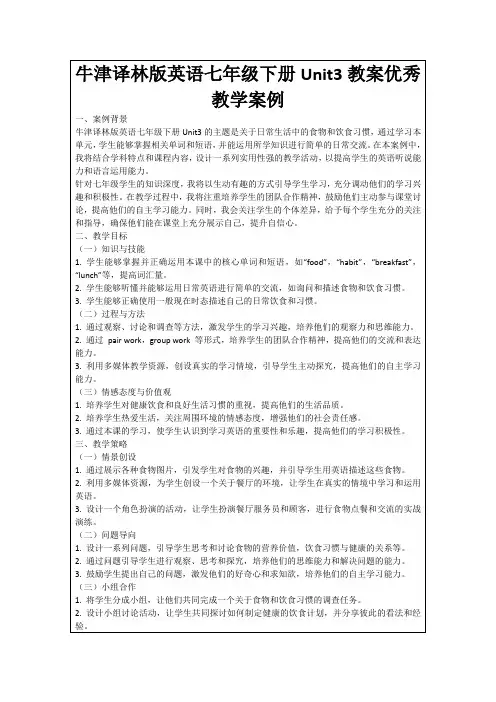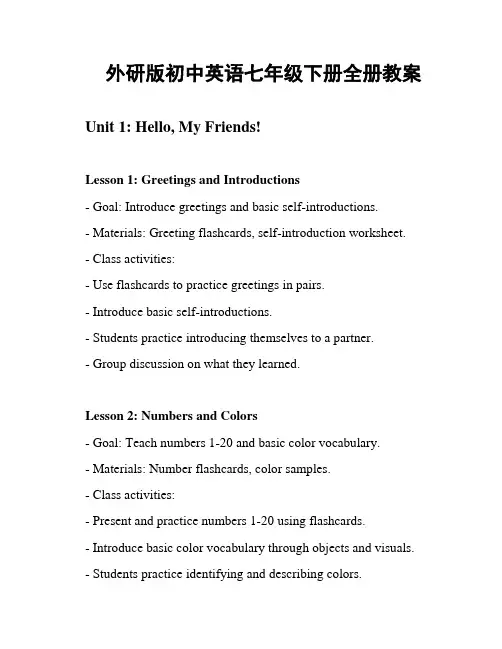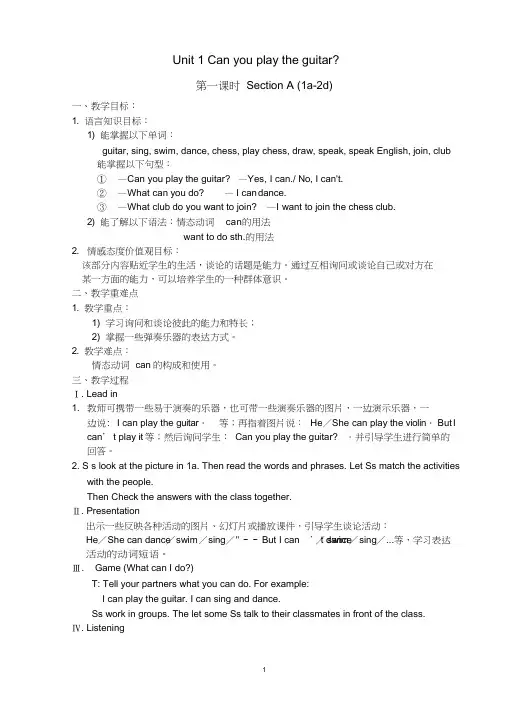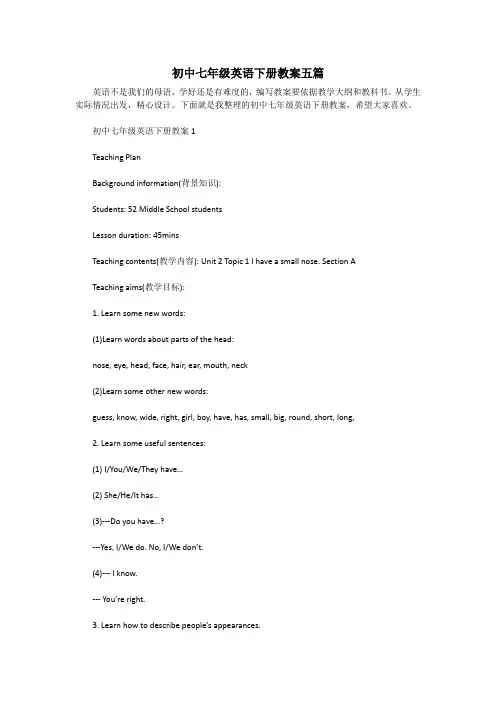七年级下册英语教案
- 格式:docx
- 大小:22.31 KB
- 文档页数:20

初一仁爱版下册英语教案初一仁爱版下册英语教案1教材分析1.本节内容就是为了进一步巩固主句为一般过去时的宾语从句,是对上一节课的巩固,并为以后的学习做了铺垫。
这节课学的知识是本册书的重点之一。
学情分析1,通过练习发现学生宾语从句并不是很懂,做起题来很蹩脚。
2,由于宾语从句是新学的语法项目,学生在日常学习中也接触,但由于在语文中并不涉及,这为英语中宾语从句的学习设置了障碍。
所以学生学起来有一定的难度。
教学目标知识与能力目标:1,学习新单词和主句为一般过去时的宾语从句;2,继续谈论时装表演,了解各民族服装;3,通过本课学习,使学生对中国服装文化能有更深刻的了解。
过程与方法:让学生在反复练习的基础上,能够很自然的掌握宾语从句。
情感态度和价值观:通过対本课的学习,让学生了解民族服装文化,加强对民族服装文化的了解,增进民族感情。
教学重点和难点主句为一般过去时的宾语从句教学过程(本文来自优秀教育资源网斐.斐.课.件.园)Step 1. Review the object clauses of which the main clauses are in the past simple tense..Step 2. Lead in the new lesson and learn new words.Step 3.Presention:1.Listen to the tape and pay attention to the pronunciation. Read 1ain different ways to learn it2. Let the students answer some questi. And then fill in blanks according to 1a.Step 4. PracticeLead into Part 2and practice the object clauses of which the main clauses are in the past simple tense.Step 5.Colidation :Step 6.Homework:教学环节一,复习二,导入三,呈现四,练习五,巩固六,作业复习宾语从句,然后利用宾语从句引入新课,并展示图片,学习生词,进而学习少数民族服装,处理第三部分。

七年级英语外研版下册教案通用5篇七年级英语外研版下册教案通用5篇英语教师研制一份教案,是为了加强课堂教学的目的性和计划性。
下面是小编为你准备的七年级英语外研版下册教案,快来借鉴一下并自己写一篇与我们分享吧!七年级英语外研版下册教案篇1一、指导思想在本学期的英语教学中,坚持《英语课程标准》中以下教学理念,面向全体学生,关注每个学生的情感,激发他们学习英语的兴趣,帮助他们建立学习的成就感和自信心,让学生在老师的指导下通过感知、体验、实践、参与和合作等方式,实现任务的目标,感受成功;注重过程评价,促进学生发展,建立能激励学生学习兴趣和自主学习能力发展的评价体系。
总之,让学生在使用英语中学习英语,让学生成为使用者而不仅仅是学习者。
让英语成为学生学习生活中最实用的工具而非累赘,让他们在使用和学习英语的过程中,体味到轻松和成功的快乐,而不是无尽的担忧和恐惧。
二、教材分析这套教材采用任务型语言教学模式,融汇话题、交际功能和语言结构,形成了一套循序渐进的生活化的学习程序。
与原教材相比还增加了文化背景和学习策略等部分,并增加了任务型学习成份和语篇的输入。
本书每个模块都列出明确的语言目标、主要的功能项目与语法结构、需要掌握的基本词汇,并分为三个单元。
Unit1部分是基本对话内容,Unit2部分是短文,主要是阅读训练。
Unit3是扩展和综合的语言运用。
三、学生基本情况分析我所任教的是七年级1、2班英语,只有少部分学生的英语基础较好,取得了一定的成绩,大多数学生不能明确学习英语的目的,没有真正认识到学习英语的目的在于交流;没有养成良好的.学习习惯,不能做好课前预习课后复习,不善于发现和总结语言规律,不注意知识的巩固和积累。
四、具体措施1、每天背诵课文中的重点对话。
目的:要求学生背诵并默写英语句子,培养学生良好的英语语感。
2、每天听写本节课中需要用到的重点生词,常用句子或习语。
利用“互测及教师抽查”及时检查,保证效果并坚持下去。


第一课时Section A (1a—2d)教学目标通过本课的学习,学生能够:1.通过课前预习、课上导入图片来学习词汇,完成本节课所涉及的词汇学习,并通过默写准确识记本课词汇,为本节课的进行做好词汇准备。
2.通过同桌、前后桌对话,完成1c/2c/2d的对话活动,能够通过练习,在口语上询问彼此的能力,描述自己的特长,学习并掌握情态动词can的用法。
3.通过独立完成1b/2a/2b的听力练习,熟悉询问同学能力的相关句型,熟悉听力内容,能够在教师的帮助下,提取有用信息,完成听力任务。
语篇研读What:本节课是Section A中的听说课,谈论自己与他人的能力,以及想要参加的学校俱乐部。
通过相关的听力练习,训练学生的听力能力。
而2d则是一个基于听力内容的口语输出活动,主要训练学生之间互相询问彼此的能力和口语表达能力。
Why:通过本课时的学习,学生能够清楚地了解自己和他人的能力,并且通过具备的能力,了解自己和他人想参加的俱乐部,在日常生活中敢于锻炼自己、展示自己。
How:通过学习与学校俱乐部相关的词汇,运用情态动词can的不同句型强化学生对谈论能力句型的掌握;借助本课语境以及参加学校俱乐部的活动鼓励学生勇敢地锻炼自我、展示自我。
教学过程设计理念:以《英语课程标准》核心素养为导向,以单元主题为引领,基于语篇的育人理念,体现《英语课程标准》“学思用创”的英语学习活动观和“教—学—评”一体化设计理念。
板书设计作业设计基础型作业:Make a conversation about joining the club and the abilities.实践型作业:Make a poster to attract others to join the club you want to set up.教学反思。

外研版初中英语七年级下册全册教案Unit 1: Hello, My Friends!Lesson 1: Greetings and Introductions- Goal: Introduce greetings and basic self-introductions.- Materials: Greeting flashcards, self-introduction worksheet. - Class activities:- Use flashcards to practice greetings in pairs.- Introduce basic self-introductions.- Students practice introducing themselves to a partner.- Group discussion on what they learned.Lesson 2: Numbers and Colors- Goal: Teach numbers 1-20 and basic color vocabulary.- Materials: Number flashcards, color samples.- Class activities:- Present and practice numbers 1-20 using flashcards.- Introduce basic color vocabulary through objects and visuals. - Students practice identifying and describing colors.- Reinforce learning with a color-matching game.Unit 2: My Family and My HomeLesson 1: Family Members- Goal: Learn how to talk about family members in English.- Materials: Family tree diagram, family member flashcards.- Class activities:- Introduce family member vocabulary using flashcards.- Present a family tree diagram and discuss relationships.- Practice asking and answering questions about family members. - Students create their own family tree diagrams.Lesson 2: My Home- Goal: Describe rooms and furniture in a house.- Materials: House diagram, furniture flashcards.- Class activities:- Introduce vocabulary for different rooms and furniture items. - Present a house diagram and label the rooms.- Students practice describing their own homes.- Group activity: Designing their dream house using English vocabulary.Unit 3: My School LifeLesson 1: School Subjects- Goal: Introduce school subject vocabulary.- Materials: Subject flashcards, timetable template.- Class activities:- Present and practice vocabulary for school subjects.- Introduce a typical school timetable.- Students create their own timetables and discuss with partners.- Group activity: Role-play a school day schedule.Lesson 2: School Facilities- Goal: Learn vocabulary for different facilities in a school.- Materials: School map, facility flashcards.- Class activities:- Introduce a school map and label the facilities.- Students describe their school environment.- Group activity: Design an ideal school using English vocabulary.Unit 4: Hobbies and InterestsLesson 1: Hobbies- Materials: Hobby flashcards, hobby survey worksheet.- Class activities:- Present and practice vocabulary for different hobbies.- Small group activity: Creating a poster about their favorite hobby.Lesson 2: Sports and Activities- Goal: Learn vocabulary related to sports and activities.- Materials: Sports flashcards, activity pictures.- Class activities:- Present and practice vocabulary for different sports and activities.- Students describe their favorite sports and activities.- Pair activity: Role-play a conversation about planning a weekend activity.- Group activity: Creating a sports and activities collage.Unit 5: Daily RoutineLesson 1: Daily Activities- Materials: Daily routine flashcards, daily routine chart.- Class activities:- Present and practice vocabulary for daily activities.- Students fill in their daily routine charts and share with partners.- Pair activity: Role-play a conversation about daily activities.Lesson 2: Telling Time- Goal: Learn how to tell time in English.- Materials: Clock flashcards, time worksheets.- Class activities:- Introduce vocabulary for different times on the clock.- Practice telling time using flashcards and worksheets.- Pair activity: Role-play a conversation about scheduling activities.- Group activity: Creating a daily schedule using English vocabulary.。

新目标人教版英语七下全册教案(全英文版)Unit 1 Wheres your pen pal from?Language goals:•In this unit students learn to talk about countries, nationalities and Ian guages.•Ask and tell where people live.New languages:•Where's he / she from?•He / She is from Australia / England / China / France / Singapore / Australia. •Where does he / she live? He / She lives in Sydney.•What language do you speak? I speak English.•What's your / his / her favorite subject?•My / His / Her favorite subject is English.•Does he / she have any brothers and sisters? Yes, he/ she does. / No, he / she doesn't.Difficult points:1. Liste ning for the in formation about cou ntries, natio nalities and Ian guages. Write an e-mail about on eself. Describe the new stude nts in class.2. Where questions with fromWhere questions with liveWhat questi onsTeaching aids:• A tape recorderTeaching periods:•Period 1:Section A 中1a, 1b, 1c•Period 2:Section A 中2a, 2b, 2c, 2d•Period 3:Section A 中3a, 3b, 4•Period 4:Section B 中1,2a, 2b, 2c•Period 5:Section B 中3a, 3b, 3c, 4•Period 6:Self CheckPeriod 1Teaching aims:1. Teach vocabulary words.2. Target Ianguages:Where's your pen pal from?He is from Australia.3. Enable the students to learn to talk about nationalities.4. Help the students learn how to talk about nationalities.Teaching procedures:Step 1. Free talk2 Say: Do you have any friends? Where is she from?Help the students make the same sentences and give them more chances to say.Step 2. Talking about the picture (1a)Hold up the picture on page 1 and point at the map. Ask students toread the picture.Ask some of you to read them aloud to the class. Make the studentstalk about where people are from.Say: Du Chuan, where is your pen pal from?Ask the students to read the conversations in the picture.Step 3. Listening (1b)Point to the numbered list of words and play the recording for a secondtime.Ask the students to listen to the recording and circle the countries in 1a.Ask students to listen to and repeat after the recording and then checkthe answers.Step 4. Pair work(1c)1. Now work in pairs and read the conversations in 1a with your partner.You can talk about your own pen pal.2. Ask the students to look at their own clothes and the things in theirbackpack. Ask and answer questions about where they are from.Homework1. Ask the students to practice talking about where people are from and make up real dialogues.2. Learn the words in this unit (on page 115) by heart.Period 2Teaching aims:1. Learn the vocabulary words and useful expressions.2. Target languages: Where does he live? He lives in Toronto.3. Let the students learn to talk about where people live.4. Help the students learn how to talk about where people live.Teaching procedures:Step I.StepI RevisionCheck the homework. And then ask several students to answer questi ons.Say: Where are you from? Do you have a pen pal? Where is your pen pal from?Step 2. Presentation (2a)Put a map of the world on the blackboard.Say: What's the meaning of capital? Can you guess? Help them to answer.Write Australia, the United States, Canada, France, and Japan on theleft of the blackboard. And write Sydney, New York, Paris, Toronto, andTokyo on the right of the blackboard. And the teacher reads them aloudand asks students to repeat.Then ask students to match the cities with the countries.Step 3. Talk about countries and citiesAsk the students to work in pairs, asking about the cities and the countries.Say: Now work in pairs and ask where the city is. For example, the firststudent asks "Where is Beijing?” the second student answers “It's inChina."Then tell the students to ask question about Chinese cities.Step 4. Listening (2b, 2c)Tell the students to read the list of countries and cities in 2a.Say: Now let's look at the list of countries and cities in Activity 2a. I will ask some students to read them aloud to the class.Call the students' attention to the chart in 2c.Tell the students to listen to the conversations in Step 4 again to complete the chart.Step 5. Pair work(2d)Ask the students to read the conversations in the bubble. Then askthem to talk about the in formation in the chart in 2c.Then ask the students to work in groups and make up new dialogueswith their own information.Step 6.GrammarfocusReview the grammar box.Say: You have to pay attention the word "from". It always follows verb be, while live comes out alone in where sentences. Now make more sentences with where, from and live.Write the following on the blackboard.Say, now work in pairs and make dialogues after the model above.Homework1. Ask the stude nts to learn the sentence patter ns in Grammar Focus by heart. Try to use them freely.2. Remember the words in this unit (on page 115).3. Make a similar dialogue according to the conversation in 2d.Period 3Teaching aims:1. Teach vocabulary words.2. Target Ianguages: What Ianguage does she speak? She speaks English.3. Enable the students to learn to talk about what Ianguage people speak.4. Help the students to learn how to talk about what language people speak.Step 1. Free talkSay, Morning, boys and girls. Nice to see you again. Do you remember we have learned about how to ask where people are from and how to ask where people live? Now I want some of you to answer my questi ons.(Turn to a student.)Where are you from?Give more students chances to speak in class.Step 2. Presentation (3a)Say: Do you know the meaning of "Ianguage"? Listen: Tim is from England and he speaks English. So English is his Ianguage. I'm fromChina, so Chinese is my language .Now look at activity 3a.on page 3.Read the instructions to the class. Ask students to work in pairs as theyanswer the questions.Show the flowing and ask the students to make conversations after themodel.Step 3. Pair work (3b)Ask the students to pay attention to the conversation in Activity 3b.Say, Read the dialogue by yourselves. Then I will ask some pairs to act out the dialogue in class.Show a map of the world. Ask students to work in pairs.Step 4. Quiz(4)Ask the students to look at activity 4 then work in pairs and do the quiz.HomeworkAsk the students to work with their friends and practice the dialogue in activity 3b.Period 4Teaching aims1. Teach vocabulary words.2. Target languages:Does she have any brothers and sisters?Is that your new pen pal?Yes, it is.3. Enable the students to learn to talk about their new pen pals.4. Help the students learn how to talk about their new pen pals.Step 1. RevisionAsk the students to make conversations talking about their new pen pal.Ask some pairs to the front to talk about their pen pals. Greet each otherand have a free talk with classmates.Talk about the persons they admire.Step 2.Match work (1)Ask the students to pay attention to the notebook page with the countries listed.Ask the students to write the letter of the correct country in the box next to the title of each Ianguage textbook on the desktop.Step 3. Listening (2a, 2b)First, read the instructions and tell the students to read the conv ersati on bubbles.Check the answers. Then ask the students to read the questions again.Ask the students to fill in the chart.Give students 1 minute to finish the task. Check the answers with the stude nts.Then play the recording again and ask the students to repeat.Step 4. Pair work (2c)Ask two students to work in pairs, practicing the questions in activity 2a.Then tell the students to practice dialogues similar to the dialogue inactivity 2a in pairs. They can use their own names.HomeworkAsk the students to make up similar dialogues using the following words: Sam, the Unites Sates, New York, a brother and a sister, English and French.Period 5Teaching aims1. Teach vocabulary words.2. Target languages:I think China is a very interesting country.I like going to the movies with my friends and playing sports.My favorite subject in school is P.E.It's fun. / It's too difficult.3. Enable the students to write a pen pal letter.4. Help the students learn how to write to a pen pal.Step 1 .Warming upSay, Do you have a pen pal? Whafs his name? Does he have any brothers and sisters? What Ianguage does he speak?Then ask the students to work in pairs to talk about their pen pal.Step 2. Reading (3a)Ask the students to read the letter on page 5.Point the four questions beneath the letter.When the students finish reading the letter, ask the four questions orally and ask them to answer orally.Ask the students to retell the letter, using their own words.Step 3. Reading and writing (3b)Ask the students to pay attention to the letter from Tom King.Point out the blanks in the letter and the information card on the right.Correct the an swers. Then draw the in formation card on the blackboard and then ask the students try to retell the letter.Step 4. WritingAsk the students make their own information card.After they are finished, ask several students to read their e-mails in class.HomeworkAsk the students to choose one of the following tasks as homework.1. Show a name card to the students and ask them to write something about it.2. The students change their information card with their partner and writesomething about their partner.Period 6Teaching aims:1. Teach vocabulary words.2. Enable the students to describe the new students in the class.3. Help the students learn to describe the new students in the class.Teaching procedures:Step 1. RevisionPractice talking about one of the students.Say, Take out your information cards. And change it with your partner.Read it carefully and make up an oral practice, talking about yourpartner.Step 2.Key word checkAsk the students to read all the words in this part.Say: In learning to talk about where people are from, you learned many words on the topic. Now read and check the words you know in 1 on page6. Then say a sentence with each of them.Step 3.Vocab-BuildersAsk students to write five new words in their Vocabulary-Builder on page 112. After they are finished, ask two students to write their words down on the blackboard. And ask them to read the words and the whole class repeat. And tell the whole class to remember them after class.Step 4.WritingLet the students pay attention to the pictures.Say, Look at the picture of Sally. How old do you think she is? Where do you think she is from? What language do you think she speaks? What do you think she likes? What do you think she dislikes?The same step goes with Jim and Julie.After a few minutes, ask some students to read their descriptions to the class.Step 5.SpeakingAsk the students to do an oral practice about the new classmates.Say, There are several new students in our class this term. Who do youlike best? Why do you like him or her? Please tell us. First you can tellyour partner.Ask some students to present their work to the class.Step 6. Just for Fun!Ask all students to read the conversation.Let the students practice in pairs.HomeworkAsk the students to summarize what they have learned in this unit and prepare for the next unit.Unit 2 Where is the post office?Language goals:•In this unit students learn to talk about asking for and give directions on the street.New languages:•Excuse me, is there a bank near here?•Yes, there is. It's on Center Street.•Where is the pay phone?•lt*s across from / next to / in front of / behind the library.•lt*s between the post office and the library.•Just go straight and tum left.•Turn left on First Avenue.•Take a walk through the park on Center Avenue.•There is a clean / dirty park near my house.Difficult points:1. Listening for the information of the names of the neighborhoodRead the tour guide and an e-mail from a friend you're going to visitWrite the dialogues about asking the way and giving directions.2. Where questions.Affirmative statementsPrepositions of placeTeaching aids:• A tape recorder•Some picturesTeaching periods:Period 1: Section A1a, 1b, 1cPeriod 2: Section A2a, 2b, 2cPeriod 3: Section A3a, 3b, 4Period 4: Section B 1a, 1b, 1c, 2a, 2b, 2cPeriod 5: Section B 3a, 3b, 3c, 4Period 6: Self CheckPeriod 1Teaching aims:1. Teach vocabulary words.2. Target Ianguages: Is there a bank near here? Yes, there is. It's on CenterStreet.3. En able the stude nts to ask for and give di recti ons on the street.4. Help the students to ask for and give directions on the street.Teaching procedures:Step 1. Warming upShow three pictures prepared before class to the students. There is acat in a box in picture 1. There is a cat on a box in picture 2. There is acat under the box in picture 3.Then ask some students to ask and answer these questions.Step 2.Match work (2a)Ask the students to read the picture and the words in the numbered list.Ask the students to match each word or phrase on the list with one of the pictures.Then check the answers.Present the new sentence patterns.Then ask the students to read the dialogue in the picture.Step 3. Listening (1b)Ask the students to listen to the conversations and circle the places in 1a.Change the roles and do the same again.Then students ask and answer without the help of the recording.Step 4. PracticePoint to the different locations shown in the picture. Ask different students to name each one.Then point to more locations and let the students to practice more.Homework1. Practice the conversation in the picture on page 7.2. Learn the new words and phrases in this period by heart.Period 2Teaching aims:1. Learn the vocabulary words and useful expressions.2. Target languages:The pay phone is across from the library.The pay phone is next to the library.The pay phone is between the post office and the library.The pay phone is on Greet Street.The pay phone is in front of the library.The pay phone is behind the library.3. Enable the students to talk about the position of a place.4. Help the students to talk about the position of a place.Teaching procedures:Step 1. Revision and warming upCheck the homework by talking about the pictures on page 7 with thestudents or prepare some other pictures with different buildings in itand let the students practice asking and answering questions about theplaces.Ask the students to practice more.Step 2. Presentation (2a)Introduce the items across from, next to, between, in front of, behind and on.Draw the following picture on the blackboard.Park 3 Centre StreetEncourage or help the students to answer: It's across from the library.The same way goes with next to, on and in front of.Ask the students to match each sentence with one of the pictures.Then ask the students to read the six sentences and match thesentences the pictures.Check the answers.Step 3. Listening(2b)Review the buildings and street names in Activity 1a and the six sentences in 2a.The read the six sentences in 2b to the class.Ask the students to listen to the recording and fill in the blanks.Play the tape. Check the answers.Step 4. Practice (2c)Ask the students to repeat the conversations after the recording.Ask the students to do the Pair work asking and answering questions about the places in 1a.Step 5.Grammar FocusAsk the students to read the sentences in the grammar box aloud. The ask them to answer the following questions. Explain some Ianguage points if the students can't understand.Homework• Ask the students to practice talking about their neighborhood in pairs.Period 3Teaching aims:1. Teach vocabulary words.2. Target Ianguages:Just go straight and turn left.It*s down Bridge Street on the right.Ifs next to a supermarket.3. Enable the students to talk about the neighborhood.4. Help the students to talk about the neighborhood.Teaching procedures:Step 1. RevisionLet the students look at the picture in activity 1a. And ask some studentsto answer some questions in order to check the homework.Say, Is there a library near here? Where is it? Is there a bank near here?Where is it?Put up the picture of activity 2a on the blackboard and ask them to makeconversations.Step 2. Presentation (3a)Guide the students to guess the meanings of the three traffic signs. Show the pictures and ask some questions about the pictures.Then ask the students to hold up their left hands and then their right hands to practice “left” and "right".Point to the picture and let the students read the conversation.Ask the students to read the conversations. Then ask them to find Paul and Nancy in the picture.Ask the students to role play the conversation then point out the place that Paul wants to get to.Step 3. Complete the conversations (3b)Ask the students to make conversations and answer the questionsbelow each picture.The students point out the place in the picture. And write down theanswers on the line in the pictures. Or ask a pair of students to say theconversation, the others point to the speakers' place.Step 4. GameAsk the students to look at the picture in Activity 1a and name all thebuildi ngs.Ask some students to read the conversation in the picture in Activity 4.And then explain the instruction to the student.Then ask some groups to present their work.Homework• Ask the students to make a similar conversation to that in Activity 3a.Period 4Teaching aims:1. Teach vocabulary words.2. Target languages:Is there a big supermarket near your house?Yes, there is.There is a big supermarket.No! There is a small supermarket.3. Enable the students to describe the neighborhood.4. Help the students to describe the neighborhood.Teaching procedures:Step 1. RevisionCheck the homework by asking the following questions.Say, Look at the picture in activity 3a. Suppose you are standing nearthe building on the side of New Street. Please answer my questions.Excuse me. Is there a pay phone in the neighborhood?Ask another student to answer questions.Give more students chances to practice this dialogue.Step 2.Match work (1a)Bring in some objects or pictures to the students. (Two rulers, one is old, the other is new. Two boxes, one is big and the other is small. Two bottles, one is clean and the other is dirty. Two pictures of a street, one is busy and the other is quiet.)Say, Look at the rulers, please. Can you find the differenee between them?Yes. This one is old. (Show the old ruler.) And this one is new. (Show the new ruler.) Do you understand old and new?Ask the students to talk about the picture.Point to each half of each picture and ask about the differenee between the halves.Go on with the other pictures to teach the language items. Ask thestudents to match the words with the pictures.Step 3. Pair workCall attention to the conversation in the picture.Then ask the students to work in pairs and take turns asking each other questions about the things on the list of phrases in activity 1a on page 7.Step 4. Listening (2a, 2b)Ask the students to listen to the tape and circle the places in 1a.Say: Now please listen to the tape again. Listen to it and draw the places in Michael's neighborhood on the street map. Just listen.Play the recording.Play the recording again.Then have some students show their completed drawing to the class. Step 5. Pair workAsk the students to work in pairs talking about drawings to the class. Then ask some pairs to present their dialogues to the class.Ask the students to work in pairs, draw a map of their own neighborhood and practice asking and answering questions about the places they live in.Homework• Ask the students to make similar conversations to that in Activity 1 b.Period 5Teaching aims:1. Teach vocabulary words.2. Target languages:Turn left on First Avenue and enjoy the city's quiet streets and small parks.Take a walk through the park on Center Avenue.This is the beginning of the garden tour.Bridge is a good place to have fun.3. Enable the students to write a tour guide and draw the rout to somewhere.4. How to write a tour guide and draw the rout to somewhere.Teaching procedures:Step 1. RevisionCheck the homework by asking about the students neighborhood.Ask the students to work in pairs.Ask the students to work in pairs.Then ask some pairs to present their conversations to the whole class. Step 2. Reading (3a, 3b)Ask the students to read the tour guide.Divide the whole class into four groups to have a quiz.Tell the students to keep these words down and make at least twosentences with each word after class.After that ask the students to look at the pictures and fill in the blanks for this tour guide.Step 3.WritingAsk the students to write a tour guide with the students.Names of buildings and locations.Description wordsWords that talk about positions.Words that talk about di recti ons.Step 4. Pair work (4b)Learn to draw a picture of neighborhood. First ask the students toanswer the questions according to the pictures.Then ask the students to draw a picture according to the following conversati on.Then ask students to present their drawings to the whole class.Homework1. Ask the students to talk about the street and buildings in their own neighborhood.2. Ask the students to make sentences with the description words they keptdown in the class.Period 6Teaching aims1. Teach vocabulary words.2. Target Ianguages:I know you are arrivi ng n ext Sun day.Let me tell you the way to my house.I hope you have a good trip.3. Enable the students to write about the neighborhood.4. Help the students to learn how to write about the neighborhood.Teaching procedures:Step 1. RevisionCheck the homework by asking and answering some questions.Give more students chances to practice.Step 2.Key word check(1)Ask the students to check the words they know.Then ask the students to do the some exercises.Step 3.Vocab-Builders (2)Expand the students' vocabulary.After that ask the students to share their list with other students.Step 4. ReadingAsk the students to read the letter and draw the rout on the map.Ask the students to change the letter into a telephone conversation.Let the students pay attention to the pictures.Say, Look at the picture of Sally. How old do you think she is? Where do you think she is from? What language do you think she speaks? What do you think she likes?What do you think she dislikes?The same step goes with Jim and Julie.After a few minutes, ask some students to read their descriptions to the class.Step 5. Just for Fun!Call attention to the conversation in the cartoons.Ask the students to read the conversation and then answer the questi ons.Homework• Ask the students to do the following:1. Suppose your frie nd is going to visit you. He does n't know the way toyour house. Write a letter to him to tell him the route from the bus stop to your house.2. Review the next unit.Unit 3 Why do you like koalas?Language goals:•In this unit students learn to describe animals and express preferences.New languages:•Let's see the pandas first.•Why do you like want to see the pan das?•Because they are very cute.•Because they*re kind of shy.•Because they're kind of interesting.•Because they are fun.•Because they are smart.•Do you like giraffes?•Where are lions from?•They are from South Africa.•The animal is ugly / beautiful / friendly / small / shy / clever / cute / scary. •She likes to play with her friends and eat grass.•She's very beautiful, but she's very shy, so please be quiet•He sleeps during the day, but at night he gets up and eats leaves.Difficult points:1. Listening for the names of animals. Listen for the description words about animals.2. Read the description words about animals. Write about the animal you know.3. why, what, where questions, because, adjectives of qualityTeaching aids:• A tape recorder•Some picturesTeaching periods:•Period 1: Section A1a, 1b, 1c•Period 2: Section A2a, 2b, 2c•Period 3: Section A3a, 3b, 4•Period 4: Section B 1a, 1b, 1c, 2a, 2b, 2c•Period 5: Section B 3a, 3b, 3c, 4• Period 6: Self CheckPeriod 1Teaching aims:1. Teach vocabulary words.2. Target languages:Let's see the pan das.Why do you want to see the lions?Because they*re cute.3. Enable the students to talk about animals.4. Help the students learn how to listen to and talk about animals.Teaching procedures:Step 1. Warming upTalk about animals using pictures.Teach new words about animals by the pictures.Step 2.Match work (1a)Ask the students to read the words and the picture, and then match thenames with the pictures a-h.Encourage or help the students to say something about the picture anddo the match work.Step 3. Listening (1b)Point to the numbered list of words in activity 1a and play the recording.Ask the students to listen to the recording and circle the countries in 1a.Play the tape and then check the answers.Ask the students to listen to and repeat after the recording and thencheck the answers.Further activity: Ask the students to do some pair work in the followingway if they can understand the listening material well.Step 4. Pair work (1c)Ask the students to make conversations in pairs.Show the following.—Let's see the pan das / giraffes / lions / penguins / dolphi ns / koalas / elepha nts / tigers?—Why?——Because they're cute / interesting / fun / interesting / smart.Say: Now please make conversations in pairs, using the animals in activity 1a and the description words in activity 1c.Homework1. Ask the students to remember the new words in this period (on page 116) by heart.2. Ask the students to practice the conversation in activity 1 c.Period 2Teaching aims:1. Learn the vocabulary words and useful expressions.2. Target languages:I like dolphins.Why do you like dolphins?Because they are kind of interesting.3. Enable the students to talk about animals and tell why they like them.4. Help the students learn to talk about animals and tell why they like them. Teachi ng procedures:Step 1. Free talk and lead-inRevise the names of the animals.Say: In last period we learnt the names of some animals. Now let's do some revision. Please look at the pictures one by one and you have to tell me the name of the animal in the picture. OK?Show the students the animal pictures one by one.Revise the conversation learnt in the last period.Give more chances to more students to practice talking about the animals and expressing why they like the animals.Step 2. Listening (2a, 2b)First ask the students to listen and fill in the chart in activity 2a.Play the recording for the first time. Ask the students to listen carefully and write down the animals.Play the tape the second time.Ask the students to pay attention to the words in the box in Activity 2b.Ask the students to pay attention to the conversation in activity 2b. After that, check the answers.Then ask the students to listen to and repeat the dialogue after therecording.After this, ask the students to practice the conversation without the help of the recording.Step 3. Pair work (2c)Ask the students to work in pairs, ask and answer about animals they know.Ask the students to practice: Why? Because they are...Step 4.GrammarfocusAsk the students to read the sentences in the grammar box and sum up the sentence structure.Practice suggest!on: Ask the students to work in groups and write down。

2024年译林版七年级英语下册全套教案教案一:Unit1DreamJobs一、教学目标1.让学生能够听懂、会说、会读、会写本单元的词汇和句型。
2.培养学生谈论职业和梦想的能力。
3.培养学生合作学习和自主探究的能力。
二、教学重难点1.词汇:doctor,teacher,policeofficer,engineer,urse,reporte,actor,ac tress等职业词汇。
2.句型:Whatdoyouwanttobe?Iwanttobeadoctor.三、教学过程1.导入教师通过图片展示不同职业,让学生猜测并说出职业名称。
学生自由讨论,分享自己的梦想职业。
2.新课学习教师播放课文录音,让学生听懂、会说本单元的词汇和句型。
教师通过PPT展示课文内容,引导学生学习课文,理解课文大意。
学生跟读课文,模仿语音、语调。
3.课堂活动学生分成小组,用本单元的词汇和句型进行角色扮演。
每个小组选一名代表进行汇报,全班投票选出最佳表演奖。
4.练习巩固教师设计一些练习题,让学生独立完成,巩固所学知识。
学生相互检查,纠正错误。
5.作业布置让学生用本单元的词汇和句型写一篇关于自己梦想职业的短文。
四、教学反思教案二:Unit2SchoolLife一、教学目标1.让学生能够听懂、会说、会读、会写本单元的词汇和句型。
2.培养学生谈论学校生活和课程安排的能力。
3.培养学生合作学习和自主探究的能力。
二、教学重难点1.词汇:math,English,Chinese,science,art,music,PE等课程名称。
2.句型:Whatsubjectsdoyouhave?Wehavemath,English,Chinese,science,ar t,music,andPE.三、教学过程1.导入教师通过图片展示不同课程,让学生猜测并说出课程名称。
学生自由讨论,分享自己的课程安排。
2.新课学习教师播放课文录音,让学生听懂、会说本单元的词汇和句型。

Unit 1 Can you play the guitar?第一课时Section A (1a-2d)一、教学目标:1. 语言知识目标:1) 能掌握以下单词:guitar, sing, swim, dance, chess, play chess, draw, speak, speak English, join, club 能掌握以下句型:①—Can you play the guitar? —Yes, I can./ No, I can't.②—What can you do? —I can dance.③—What club do you want to join? —I want to join the chess club.2) 能了解以下语法:情态动词can的用法want to do sth.的用法2. 情感态度价值观目标:该部分内容贴近学生的生活,谈论的话题是能力。
通过互相询问或谈论自己或对方在某一方面的能力,可以培养学生的一种群体意识。
二、教学重难点1. 教学重点:1) 学习询问和谈论彼此的能力和特长;2) 掌握一些弹奏乐器的表达方式。
2. 教学难点:情态动词can 的构成和使用。
三、教学过程Ⅰ. Lead in1. 教师可携带一些易于演奏的乐器,也可带一些演奏乐器的图片,一边演示乐器,一边说: I can play the guitar.等;再指着图片说:He/She can play the violin.But I can’t play.it 等;然后询问学生:Can you play the guitar? .并引导学生进行简单的回答。
2. S s look at the picture in 1a. Then read the words and phrases. Let Ss match the activitieswith the people.Then Check the answers with the class together.Ⅱ. Presentation出示一些反映各种活动的图片、幻灯片或播放课件,引导学生谈论活动:He/She can dance/swim/sing/" ··But I can ’/t d sa w n im ce/sing/...等,学习表达活动的动词短语。

七年级英语下册全英文教案(全册全英文)Unit 1 Can you play the guitar?Step 1 LeadingT:What do they do in the picture?S:They...(见课件)T:Can you/he sing/ swim/ dance...?S:I/He can...T:There are many clubs.What club do you want to join?(见课件)S:I want to join the music club.Because I can sing....Step 2 Listening1.Ask the students to read the conversations in 1b first.2.Ask the students to listen and number the conversations [1-3] in 1b.3.Check the answers.(见课件)4.Ask the students to read the club names in 2a.5.As k the students to listen to two conversations and circle the clubs they hear.6.Ask one student to show the answers.(见课件)7.Listen again and complete the sentences in 2b.8.Ask three students to show their answers.(见课件)Step 3 Make similar conversations1.Look at 2b and talk ab out what the people can do and the clubs they want to join.2.Show an example.(见课件)Step 4 Role-play1.Ask the students to read the conversation in 2d,try to find:What can Jane/ Bob do?What club do they want to join?2.Ask the students to fill in the form.(见课件)What can...do? What club does...want to join? BobJane3.Ask students to practice the conversation according to the for m.4.Ask students to perform the conversation.Step 5 Explain several important words and phrases.(见课件)Step 6 HomeworkMake a survey about what your friends can do and what club your friends want to join. 板书设计Section A(1a-2d)重点单词短语重点句型1.play the guitar/play basketball2.want to do sth.3.join/join in/take part i n4.be good atUnit 1 Can you play the guitarImportant phrases:talk to,kung fuImportant sentences:1.—Can yo u/he/they swim?—Yes,I/he/they can./—No,I/he/they can’t.2.—What can you do?—I can dance./ I can’t sing.3.—What club do you want to join?—We want to join the chess club.【能力目标】能熟练运用所学目标语言谈论自己所长。

初中七年级英语下册教案五篇英语不是我们的母语,学好还是有难度的,编写教案要依据教学大纲和教科书。
从学生实际情况出发,精心设计。
下面就是我整理的初中七年级英语下册教案,希望大家喜欢。
初中七年级英语下册教案1Teaching PlanBackground information(背景知识):Students: 52 Middle School studentsLesson duration: 45minsTeaching contents(教学内容): Unit 2 Topic 1 I have a small nose. Section ATeaching aims(教学目标):1. Learn some new words:(1)Learn words about parts of the head:nose, eye, head, face, hair, ear, mouth, neck(2)Learn some other new words:guess, know, wide, right, girl, boy, have, has, small, big, round, short, long,2. Learn some useful sentences:(1) I/You/We/They have…(2) She/He/It has…(3)---Do you have…?---Yes, I/We do. No, I/We don’t.(4)--- I know.--- You’re right.3. Learn how to describe people’s appearances.Teaching focus(重点):words about parts of the head and adjectives of description Teaching difficulties(难点):The usages of have and hasTeaching procedures:(教学步骤)Step1 Warm-up 第一步热身greetingsing a song : Head and shoulders.Step2 Review 第二步复习(1) 通过复习,培养学生根据卡片信息进行简单交流的能力。

七年级英语下册教案篇一:2022人教版七年级下册全册英语教案英语七年级(下)教案一、【教学目标】(一)语言知识1.词汇掌握wake,early, first,day, term,must,still,by,onfoot,the same to,usually,always,Ms.,boat,ship,sea,train,by plane/air/airplane, etc.2.理解Subway Worm reporter,Net Bar,roller skating Measuredining hall,dormitory bookstore,etc. (二)语法1.一般现在时(Simple present)2.频度副词(Adverbs of frequency)never, seldom, sometimes,often, usually, always, once, twice3.现在进行时(Present continuous) a. I’m looking for a book.b. Are you doing your homework? Yes, I am./No, I’m not.c. Is he/she...?Yes, he/she is. /No, he/she isn’t.d. What are you doing now? I’m playing computer games.e. What is he/she doing? He/She is...4.谈论交通方式(Talking about means of transportation) How do you usually go to school? I usually go to school by bike. (三)功能用语与话题1.采访(Interviews)Our guest today is Michael from Class 2, Grade 1.2.谈论日常生活(Talking about routines)3.学校建筑(School buildings)swimming pool, playground,library, dormitory, lab, gym4.谈论兴趣喜好(Talking about interests, likes and dislikes)I like the swimming pool best. Why do you like English? Because it’s interesting and easy. 5.借物(Borrowing things)How long can I keep it? Two weeks. 6.新闻(News)、海报(Poster)Attention,please! Here is the news.7.谈论学校活动、科目和时间表(Talking about school activities,subjects and timetable) 8.谈论学校生活(Talking about school life)(四)能力培养【听】能听懂谈论校园生活中比较熟悉的话题,识别主题,获取主要信息。
最新2023年部编人教版英语七年级下册教案(全册)第一单元:认识新同学教学目标:- 研究并复关于个人信息的表达方式,如姓名、年龄、国籍等;- 研究并掌握相互问候和自我介绍的常用表达;- 能够用简单句子互相介绍自己和他人。
教学内容:1. 单词及词组- 名字(name)、国籍(nationality)、年龄(age)、学校(school)、家庭(family)、班级(class)、手机号码(phone number)、电子邮箱(email address)、问候语(greetings)、自我介绍(self-introduction)2. 语法- 一般现在时的肯定句和疑问句教学流程:1. 导入新课,介绍并复相关单词和词组。
2. 模仿示范,带领学生用一般现在时谈论个人信息。
3. 练相互问候和自我介绍。
4. 进行小组活动,让学生互相介绍自己和同学。
5. 梳理语法知识,引导学生理解一般现在时的构成和用法。
6. 进行语法练,巩固学生对一般现在时的掌握。
7. 总结本节课的内容,布置相关作业。
教学资源:- 《最新2023年部编人教版英语七年级下册》教材- 多媒体课件- 黑板和白板- 学生练册注:以上内容仅为简要介绍,具体的教案细节请参考教材及教师指导手册。
以上是《最新2023年部编人教版英语七年级下册教案(全册)》第一单元的简要内容。
本单元旨在帮助学生复习和掌握关于个人信息的表达方式,以及相互问候和自我介绍的常用表达。
通过多种教学活动和练习,学生将能够用简单句子互相介绍自己和他人,并掌握一般现在时的构成和用法。
详细的教案内容请参考教材及教师指导手册。
一、单元学习主题
本课主题属于“人与自我”主题范畴中“生活与做事”这一主题群,涉及子主题“自我管理”。
二、单元内容分析
本单元分为Section A 与Section B两部分,主要围绕话题“daily routines and times”展开听、说、读、写、看等语言活动。
本单元共有五个主要语篇,第一、二个语篇是对话的形式,通过记者对Rick和Jim的两篇采访,说明了合理安排时间的重要性;第三、四个语篇也是采访对话,分别通过记者对Scott和Tom的采访,介绍了两人的日常作息习惯;第五个语篇由两段短文构成,以“健康生活习惯”为主题,讲述了Tony和Mary姐弟两人不同的生活习惯。
五个语篇不仅为我们传递了不同的语言知识和语篇知识,也传递了“珍惜时间,保持良好生活习惯”的育人价值。
单元主题内容结构框架见下图:。
教案:七年级英语下册Uni What Does He Look Like教案人教版教学目标:1. 能听懂、会说、会读本课的生词和短语。
2. 能正确运用What does he/she look like? 询问某人的外貌特征。
3. 能用形容词描述某人的外貌特征。
4. 能用There be句型描述某人的外貌特征。
教学内容:Lesson 1: What Does He Look Like?1.1 生词和短语:What: 什么Does: 做He: 他Look: 看起来Like: 像He look like: 他看起来像She look like: 她看起来像a teacher: 一个老师a doctor: 一个医生a worker: 一个工人a student: 一个学生a farmer: 一个农民a Policeman: 一个警察a postman: 一个邮递员1.2 句型结构:What does he/she look like? 他/她看起来像什么?He/She looks like a teacher/doctor/worker/student/farmer/Policeman/postman. 他/她看起来像一个老师/医生/工人/学生/农民/警察/邮递员。
1.3 对话:A: What does your father look like? 你父亲看起来像什么?B: He looks like a worker. 他看起来像一个工人。
A: What does your mother look like? 你母亲看起来像什么?B: She looks like a teacher. 她看起来像一个老师。
Lesson 2: What Does She Look Like?2.1 生词和短语:She: 她What: 什么Does: 做Look: 看起来Like: 像She look like: 她看起来像a teacher: 一个老师a doctor: 一个医生a worker: 一个工人a student: 一个学生a farmer: 一个农民a Policeman: 一个警察a postman: 一个邮递员2.2 句型结构:What does she look like? 她看起来像什么?She looks like a teacher/doctor/worker/student/farmer/Policeman/postman. 她看起来像一个老师/医生/工人/学生/农民/警察/邮递员。
2024年译林版七年级英语下册全套教案一、教学内容1. Unit 1: Dream homesSection A: Reading (Pages 23)Section B: Listening and speaking (Pages 45)Section C: Writing (Page 6)2. Unit 2: NeighboursSection A: Reading (Pages 89)Section B: Listening and speaking (Pages 1011)Section C: Writing (Page 12)二、教学目标1. 让学生掌握与家庭、邻居以及居住环境相关的词汇和句型,提高学生的英语表达能力。
2. 培养学生的听力理解能力,使学生能够理解并运用目标语言进行日常交流。
三、教学难点与重点1. 教学难点:词汇和句型的运用,听力理解,写作技巧。
2. 教学重点:家庭、邻居以及居住环境相关词汇,一般现在时和一般过去时的运用,听力技巧,写作结构。
四、教具与学具准备1. 教具:多媒体设备,PPT,黑板,教材。
2. 学具:练习本,笔,听力材料。
五、教学过程1. 导入:通过展示不同国家的家庭和邻居图片,引出本单元话题,激发学生兴趣。
2. 新课内容展示:a. Section A: 介绍阅读文章,讲解生词和短语,分析文章结构,引导学生复述文章内容。
b. Section B: 播放听力材料,指导学生完成相关练习,讲解答案,分析听力技巧。
c. Section C: 讲解写作技巧,展示范文,引导学生仿写。
3. 随堂练习:针对新课内容,设计相关练习,巩固所学知识。
4. 小组活动:分组讨论,让学生运用所学词汇和句型进行角色扮演,提高学生的口语表达能力。
六、板书设计1. 板书左侧:列出本节课所学词汇和短语。
2. 板书右侧:展示重点句型和语法。
3. 黑板中央:展示本节课的教学目标和练习题目。
七、作业设计1. 作业题目:a. 根据Section A阅读文章,仿写一篇关于自己家庭的短文。
七年级下复习教案
大单元教学设计一,单元内容分析(课标分析)
二,单元教学目标
三,学情分析
总复习阶段,学生的态度总体较为积极。
绝大多数学生对英语总复习持有较高的兴趣和主动学习态度。
他们愿意参与课堂活动,并愿意主动与教师和同学进行交流。
然而,也有一部分学生对英语复习缺乏热情,需要教师的教育和激励,大部分学生的英语整体水平较为均衡。
大多数学生能够熟练掌握基本的英语语法和词汇,并能够进行简单的听说读写。
然而,仍有一部分学生的英语水平相对较低,需要额外的支持和指导。
四,教学要点和课时安排
单元分课时设计
单元分课时设计
单元分课时设计。
新版PEP小学英语七年级下册全册教案教学目标本教案旨在帮助七年级学生掌握下册英语书中的全部知识点和技能。
具体教学目标如下:- 听力:能够听懂简单的日常用语和指令- 口语:能够用英语进行简单的日常交流- 阅读:能够阅读简单的英语短文,并理解其基本内容- 写作:能够写出简单的英语句子和短文教学内容本教案包含全册的全部教学内容,包括各单元的词汇、语法和对话练等。
具体内容如下:Unit 1 - Greetings- 词汇:hello, hi, good morning, good afternoon, good evening- 语法:句子结构和基本问候用语Unit 2 - Family- 词汇:family members (father, mother, brother, sister, etc.), grandparents- 语法:形容词的比较级和最高级Unit 3 - School- 词汇:classroom, teacher, student, desk, chair, etc.- 语法:可数和不可数名词,数量词...(继续列举后续各单元的内容)教学方法本教案采用多元化的教学方法,包括教师讲解、学生互动、多媒体辅助等。
教师可以根据学生的实际情况和教学需要,灵活使用以下方法:- 听力训练:播放录音,让学生跟读或回答问题- 口语练:参与对话,进行角色扮演- 阅读理解:根据短文内容回答问题,进行课堂讨论- 写作练:写出简单的英语句子和短文,进行作业批改教学评估为了评估学生对教学内容的掌握程度,可以采用以下评估方法:- 听力测试:播放录音,要求学生根据听到的内容选择正确答案- 口语表达:进行对话练,评估学生的口语交流能力- 阅读理解:提供一篇简短的英语短文,要求学生回答相关问题- 写作任务:布置相关的写作任务,评估学生的写作水平教学资源本教案需要使用以下教学资源:- 新版PEP小学英语七年级下册教材- 听力录音文件- 多媒体设备(投影仪、电脑等)以上是新版PEP小学英语七年级下册全册教案的概要。
七年级下册英语教案第一篇:七年级下册英语教案七年级下册英语(外语教学与研究出版社)学生用书(students book 2 )module 2 spring festivalunit Iwere getting ready for spring festival.teaching planning课题内容:(1)本模块的话题是节日。
本单元要求学生掌握描述节日的表达方式,同时加强学生对中外节日的理解与认识。
通过使用现在进行时,对该话题展开听、说、读、写的语言实践活动,使学生加深能够谈论或写出对该节日的介绍。
并让学生了解一些重要节日的庆祝方式。
(2)通过对本模块的学习,有助于学生了解世界,在一定程度上提高学习效率,并形成自主学习的能力,为学生养成良好的学习习惯打下良好的基础。
(3)教学中教师应随时随地地以课本为出发点,灵活运用各种素材组织教学过程和内容。
i、teaching goals1. make an introduction of the spring festival2. newwords :festivalreadycleancooklearnmealdragonlanternsweepfloorhelpnew phrases: spring festivalget ready fordragon danceclean the housesweep the floormake lanternscook the mealat work3. grammar focus: the questions and answers of the present continuous and the present simpletense sentencesii、ability goals1. enable students to understand the conversation about the spring festival2. enable students to recognize phrases and short answers3. enable students to talk about the spring festival with given information and describe the process of festival preparations iii、emotional goals1. enable students to be willing to know festivals of different places, and be happy to take part in some english practice activities.2. by doing so, students interests in englishlearning will be developed and improved.3. cultivate students enthusiasm for exotic cultureand their passion for life tradions. all these will ,to a certain extent, enhance students understanding of domestic culture .4. students participate in various english activities,going through all kinds ofdifficulties ,which enable them to establish correct language learning value in new environment.iv、important points1」earning new words and phrases2. understanding the present continuous tense sentences in the textbook by reading3. having a good commandof the structure and usage of the present continuous tensedi fficult pointsthe comparison between the structure and usage ofthe present continuous tense and the present simple tense vi、teaching aids and methodsteaching aids: color picturestape-recordermoney in red envelopehand-outblackboardteaching method: task-based teaching approachvii、teaching procedures1.1 ead-in(pre-task)("greeting(2)recall what we have learned in the last lesson.(the present continuous tense) (重述现在进行时的含义)由下面的例子引入:t: what are we doing now?s: we are having an english class.2. while-taskstep 1:show the students the money in the red envelope .this is lucky money. when can we get lucky money? yes, we can get lucky money in the spring festival. teach students the new phrase : spring festival.step 2:you know people are very busy before the spring festival. and what do people often do before the spring festival? present the title of this lesson: were getting ready for spring festival.teach students the new phrase: get ready fornewword: readystep 3show students some color pictures and say :look atthese pictures. from the pictures , we can see people arevery busy. what are they doing? who can tell me? you canspeak in chinese.several students stand up to answer the teachers questions.teach students new wordsand phrases :cleancookmeallanterndragonsweepfloorsweep the floorcook the mealclean the housedragon dancemake lanternsso, people in the pictures are getting ready forspring festival.step 4:look and say.look at the pictures again and say what they are doing.they are…..they are….theyare…..(practice v-ing 句型)step 5 :t: can you do these things in the pictures?ask twoor three students to answer thequestions.( 举例子)if you cannot do these things, you must learn todo them.teach students the new word :learn.so , if you can do these things ,you can help yourparents before the spring festival.teach students the new word: helpand your parents will be very happy.maybe your parents will give you some lucky money. step 6:1. match and check.2.listen and reading on page 8.the spring festival is coming. people are gettingready for it. there is a dialogue among lingling bettyand tony.(1) listen to the tape.(2) work in group of 3.t: at first, you should say :i am lingling,i ambetty ,i am tony.are you clear? ask the three groupsto act out the dialogue. and then ask students whichgroup is best. give the best group a small present.step 7:1. complete part 3..t: are the boys making lanterns?s: yes, they are.|no, they arent.(再举几个例子练习,让两个学生为一组反复操练现在进行时的简短回答,通过反复练习让学生熟悉并最终掌握)。
2. complete part 4.ask two students as a group to practice .there aresix groups in all.诚:homework1. finish part 5: pronunciation.2. work with your partner to practice part 6.3. finish the handout.第二篇:新目标七年级下册英语教案新目标七年级下册英语教案:unit 3 why do you like koalas? 一、教学内容分析本单元是go for it 七年级上册中第八单元when is your birthday?。